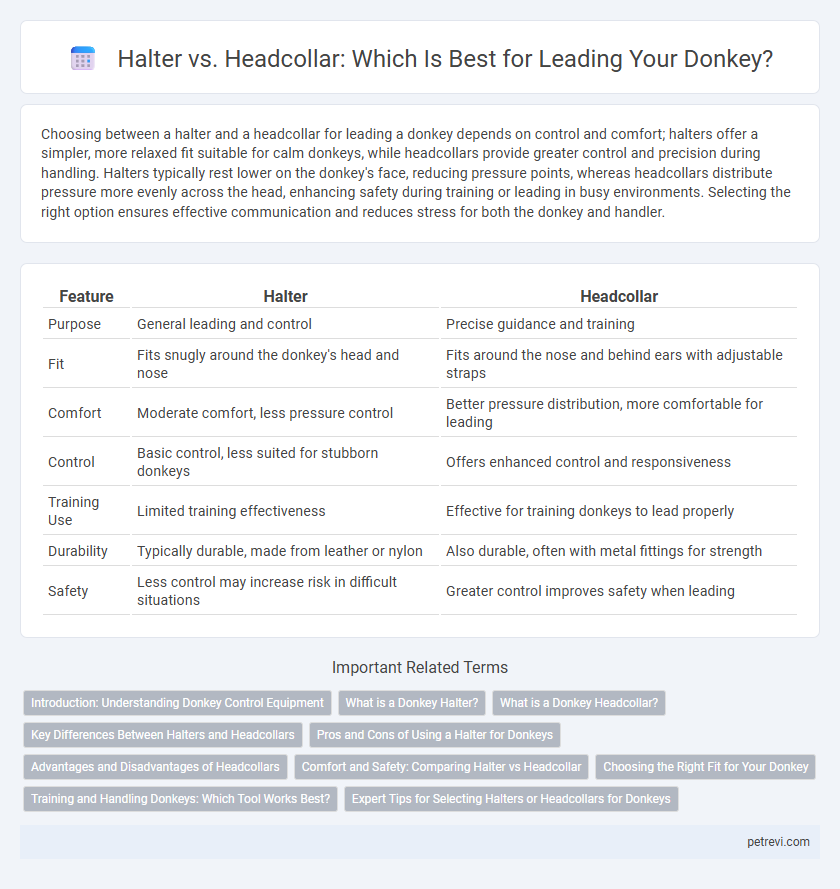Choosing between a halter and a headcollar for leading a donkey depends on control and comfort; halters offer a simpler, more relaxed fit suitable for calm donkeys, while headcollars provide greater control and precision during handling. Halters typically rest lower on the donkey's face, reducing pressure points, whereas headcollars distribute pressure more evenly across the head, enhancing safety during training or leading in busy environments. Selecting the right option ensures effective communication and reduces stress for both the donkey and handler.
Table of Comparison
| Feature | Halter | Headcollar |
|---|---|---|
| Purpose | General leading and control | Precise guidance and training |
| Fit | Fits snugly around the donkey's head and nose | Fits around the nose and behind ears with adjustable straps |
| Comfort | Moderate comfort, less pressure control | Better pressure distribution, more comfortable for leading |
| Control | Basic control, less suited for stubborn donkeys | Offers enhanced control and responsiveness |
| Training Use | Limited training effectiveness | Effective for training donkeys to lead properly |
| Durability | Typically durable, made from leather or nylon | Also durable, often with metal fittings for strength |
| Safety | Less control may increase risk in difficult situations | Greater control improves safety when leading |
Introduction: Understanding Donkey Control Equipment
Halter and headcollar are essential donkey control equipment designed for secure and comfortable leading. Halters typically feature adjustable straps encircling the donkey's head, providing precision control without causing discomfort. Headcollars, often padded and reinforced, offer gentle guidance while minimizing stress on the donkey's sensitive facial areas.
What is a Donkey Halter?
A donkey halter is a piece of equipment designed to fit comfortably around the donkey's head, providing control during leading or handling. Typically made from nylon, leather, or rope, a halter includes straps that go over the nose and behind the ears, distributing pressure evenly to prevent injury. Unlike a headcollar, a halter is primarily used for general leading and tying rather than detailed training or riding control.
What is a Donkey Headcollar?
A donkey headcollar is a device designed to fit around a donkey's head, providing control for leading and handling without causing discomfort. It typically features adjustable straps around the poll and nose, allowing for secure guidance while minimizing pressure on sensitive areas. Unlike a halter, the headcollar offers more precise steering and is preferred for training and everyday handling of donkeys.
Key Differences Between Halters and Headcollars
Halter and headcollar differ primarily in design and control functions when leading donkeys; halters are typically made of softer materials and provide basic control around the head, ideal for general handling and comfort. Headcollars incorporate a noseband and throat latch, offering increased control and precise guidance, especially useful for training or managing more spirited donkeys. Choosing between the two depends on the donkey's behavior, training level, and the handler's need for control versus comfort.
Pros and Cons of Using a Halter for Donkeys
Using a halter for leading donkeys offers better control due to its close fit around the head, which helps prevent the donkey from pulling or escaping. However, halters can cause discomfort or injury if not properly adjusted, as their straps may press against sensitive areas like the poll and nose. While halters are durable and effective for training strong donkeys, they require careful monitoring to avoid rubbing, sores, or stress during prolonged use.
Advantages and Disadvantages of Headcollars
Headcollars provide greater control and are effective for leading donkeys, especially in training and handling situations due to their design that applies pressure on the nose and poll. They can cause discomfort or injury if improperly fitted or used too harshly, making gentle handling essential. Compared to halters, headcollars offer improved precision in guiding but require careful adjustment to avoid stress or behavioral issues in donkeys.
Comfort and Safety: Comparing Halter vs Headcollar
Halter and headcollar both serve as essential tools for leading donkeys, but their design differences impact comfort and safety. Halters, typically made of softer materials, provide a gentler fit around the donkey's nose and head, reducing pressure points and risk of injury, making them preferable for sensitive animals. Headcollars offer more control by distributing pressure across the head and jaw but require careful adjustment to avoid discomfort or respiratory issues, emphasizing the necessity of proper fitting for safe handling.
Choosing the Right Fit for Your Donkey
Selecting the appropriate halter or headcollar for donkey leading ensures comfort and control while preventing injuries. Halters typically offer adjustable fittings that accommodate a donkey's unique head shape, promoting a secure fit without causing undue pressure. Headcollars, often padded and designed for gentle guidance, provide effective lead management, making them ideal for everyday handling and training.
Training and Handling Donkeys: Which Tool Works Best?
Halter and headcollar serve distinct roles in donkey training and handling, influencing control and comfort during leading. Halters provide a secure fit ideal for basic leading and ground training, promoting effective communication without discomfort. Headcollars offer precise guidance suited for experienced handlers, enhancing maneuverability and responsiveness in more advanced training scenarios.
Expert Tips for Selecting Halters or Headcollars for Donkeys
Selecting the right halter or headcollar for donkey leading requires understanding the animal's unique facial structure and temperament. Experts recommend adjustable, padded halters made of durable material like nylon or leather to ensure comfort and control without causing pressure points or chafing. Proper fit should allow enough room to prevent rubbing while maintaining secure guidance, especially for donkeys with broader noses and sensitive skin.
Halter vs Headcollar for Donkey Leading Infographic

 petrevi.com
petrevi.com